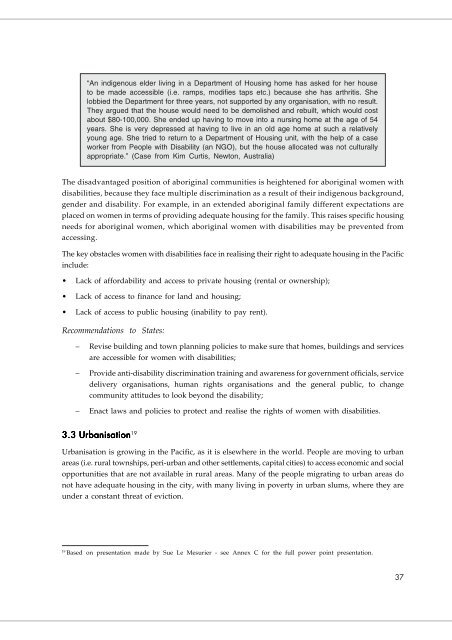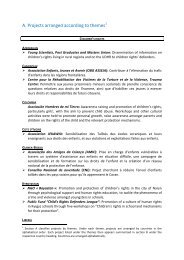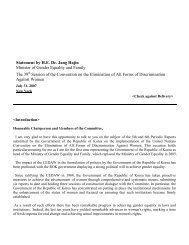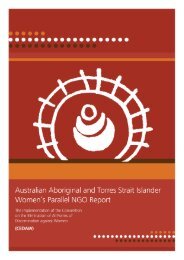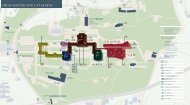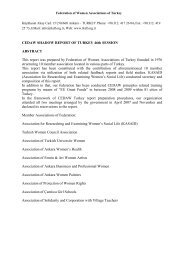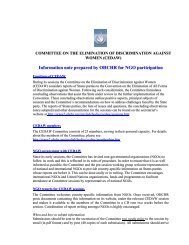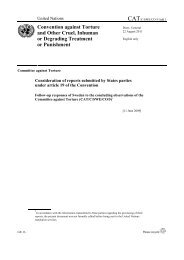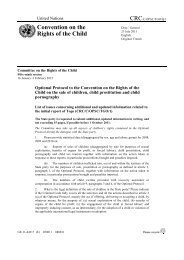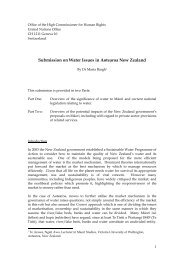Report - Office of the High Commissioner on Human Rights
Report - Office of the High Commissioner on Human Rights
Report - Office of the High Commissioner on Human Rights
- No tags were found...
Create successful ePaper yourself
Turn your PDF publications into a flip-book with our unique Google optimized e-Paper software.
“An indigenous elder living in a Department <str<strong>on</strong>g>of</str<strong>on</strong>g> Housing home has asked for her house<br />
to be made accessible (i.e. ramps, modifies taps etc.) because she has arthritis. She<br />
lobbied <str<strong>on</strong>g>the</str<strong>on</strong>g> Department for three years, not supported by any organisati<strong>on</strong>, with no result.<br />
They argued that <str<strong>on</strong>g>the</str<strong>on</strong>g> house would need to be demolished and rebuilt, which would cost<br />
about $80-100,000. She ended up having to move into a nursing home at <str<strong>on</strong>g>the</str<strong>on</strong>g> age <str<strong>on</strong>g>of</str<strong>on</strong>g> 54<br />
years. She is very depressed at having to live in an old age home at such a relatively<br />
young age. She tried to return to a Department <str<strong>on</strong>g>of</str<strong>on</strong>g> Housing unit, with <str<strong>on</strong>g>the</str<strong>on</strong>g> help <str<strong>on</strong>g>of</str<strong>on</strong>g> a case<br />
worker from People with Disability (an NGO), but <str<strong>on</strong>g>the</str<strong>on</strong>g> house allocated was not culturally<br />
appropriate.” (Case from Kim Curtis, Newt<strong>on</strong>, Australia)<br />
The disadvantaged positi<strong>on</strong> <str<strong>on</strong>g>of</str<strong>on</strong>g> aboriginal communities is heightened for aboriginal women with<br />
disabilities, because <str<strong>on</strong>g>the</str<strong>on</strong>g>y face multiple discriminati<strong>on</strong> as a result <str<strong>on</strong>g>of</str<strong>on</strong>g> <str<strong>on</strong>g>the</str<strong>on</strong>g>ir indigenous background,<br />
gender and disability. For example, in an extended aboriginal family different expectati<strong>on</strong>s are<br />
placed <strong>on</strong> women in terms <str<strong>on</strong>g>of</str<strong>on</strong>g> providing adequate housing for <str<strong>on</strong>g>the</str<strong>on</strong>g> family. This raises specific housing<br />
needs for aboriginal women, which aboriginal women with disabilities may be prevented from<br />
accessing.<br />
The key obstacles women with disabilities face in realising <str<strong>on</strong>g>the</str<strong>on</strong>g>ir right to adequate housing in <str<strong>on</strong>g>the</str<strong>on</strong>g> Pacific<br />
include:<br />
• Lack <str<strong>on</strong>g>of</str<strong>on</strong>g> affordability and access to private housing (rental or ownership);<br />
• Lack <str<strong>on</strong>g>of</str<strong>on</strong>g> access to finance for land and housing;<br />
• Lack <str<strong>on</strong>g>of</str<strong>on</strong>g> access to public housing (inability to pay rent).<br />
Recommendati<strong>on</strong>s to States:<br />
– Revise building and town planning policies to make sure that homes, buildings and services<br />
are accessible for women with disabilities;<br />
– Provide anti-disability discriminati<strong>on</strong> training and awareness for government <str<strong>on</strong>g>of</str<strong>on</strong>g>ficials, service<br />
delivery organisati<strong>on</strong>s, human rights organisati<strong>on</strong>s and <str<strong>on</strong>g>the</str<strong>on</strong>g> general public, to change<br />
community attitudes to look bey<strong>on</strong>d <str<strong>on</strong>g>the</str<strong>on</strong>g> disability;<br />
– Enact laws and policies to protect and realise <str<strong>on</strong>g>the</str<strong>on</strong>g> rights <str<strong>on</strong>g>of</str<strong>on</strong>g> women with disabilities.<br />
3.3 Urbanisati<strong>on</strong> 19<br />
Urbanisati<strong>on</strong> is growing in <str<strong>on</strong>g>the</str<strong>on</strong>g> Pacific, as it is elsewhere in <str<strong>on</strong>g>the</str<strong>on</strong>g> world. People are moving to urban<br />
areas (i.e. rural townships, peri-urban and o<str<strong>on</strong>g>the</str<strong>on</strong>g>r settlements, capital cities) to access ec<strong>on</strong>omic and social<br />
opportunities that are not available in rural areas. Many <str<strong>on</strong>g>of</str<strong>on</strong>g> <str<strong>on</strong>g>the</str<strong>on</strong>g> people migrating to urban areas do<br />
not have adequate housing in <str<strong>on</strong>g>the</str<strong>on</strong>g> city, with many living in poverty in urban slums, where <str<strong>on</strong>g>the</str<strong>on</strong>g>y are<br />
under a c<strong>on</strong>stant threat <str<strong>on</strong>g>of</str<strong>on</strong>g> evicti<strong>on</strong>.<br />
19<br />
Based <strong>on</strong> presentati<strong>on</strong> made by Sue Le Mesurier - see Annex C for <str<strong>on</strong>g>the</str<strong>on</strong>g> full power point presentati<strong>on</strong>.<br />
EXECUTIVE SUMMARY 37


